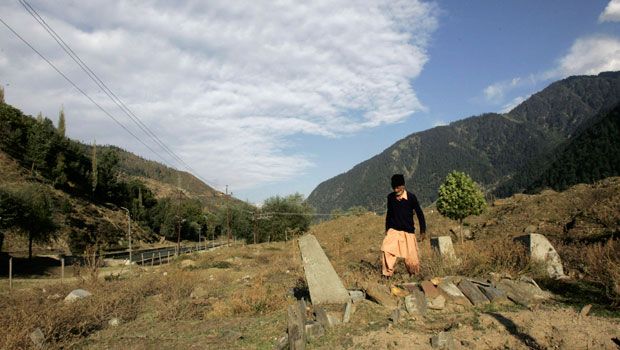It is not surprising at all that the chief minister of Indian Kashmir, Omar Abdullah’s written statement on the disappeared persons, in the assembly on Oct 8 should have been received with complete disbelief.
He said, “Till ending July 2012, 2,305 persons have been declared missing.” FIRs were lodged only in 182 cases. In the rest of the cases, “missing reports and complaints have been lodged”.
Sana Altaf of the Srinagar daily Greater Kashmir noted “even after 23 years of armed conflict, no authentic official data exists on the number of disappeared persons in Kashmir valley while successive governments continue to come up with contradictory figures”.
According to the National Conference government headed by Farooq Abdullah the official figure of disappeared persons stood at 3,184. The then People’s Democratic Party government headed by Mufti Sayeed informed the assembly in February 2003 that 3,744 persons went missing between 2000 and 2002.
According to the Srinagar-based Association of Parents of Disappeared Persons (APDP) which has rendered yeoman service all these years, at least 8,000 persons have disappeared since the militancy began in 1989. Punjab witnessed a similar pattern of abuse and cover-up during the counter-insurgency operations from 1984 to 1995.
An inquiry by the police investigation team of the Jammu and Kashmir State Human Rights Commission (SHRC) has found 2,730 bodies dumped into unmarked graves in four districts.
The Inquiry Report of Unmarked Graves in north Kashmir, submitted by the investigating police team to the SHRC on July 2, 2011, said that the unidentified bodies had been buried in 38 sites in the Baramulla, Bandipora, Handwara and Kupwara districts. At least 574 were identified as the bodies of local Kashmiris. The government had previously said that the graves held unidentified militants.
Meenakshi Ganguly, South Asia director of Human Rights Watch, said: “For years, Kashmiris have been lamenting their lost loved ones, their pleas ignored or dismissed as the government and army claimed that they had gone to Pakistan to become militants. But these graves suggest the possibility of mass murder. The authorities should immediately investigate each and every death.”
The Inquiry Report recommended that the SHRC call for immediate DNA sampling and other forensic tests to try to identify the bodies by matching them with the next of kin of the people who have disappeared. Seventeen of the bodies found in the four districts have already been reburied by relatives in family graveyards. The investigation found that 18 of the graves contained more than one body. But the Kashmir government has refused to conduct DNA tests to identify the bodies.
New terms have come into vogue. The wife of a ‘disappeared’ man is called ‘half-widow’. International law, especially international humanitarian law, has begun to grapple with the problem. For long the chairperson of the Working Group on Enforced or Involuntary Disappearances studied the record in some countries and reported to the then UN Human Rights Commission at Geneva now replaced by the Human Rights Council.
The International Convention on the Protection of All Persons from Enforced Disappearances defines enforced disappearances as “the arrest, detention, abduction or any other form of deprivation of liberty by agents of the state or by persons or groups of persons acting with the authorisation, support or acquiescence of the state, followed by a refusal to acknowledge the deprivation of liberty or by concealment of the fate or whereabouts of the disappeared person, which place such a person outside the protection of the law”.
The convention grants all persons directly harmed by an enforced disappearance, such as family members of the disappeared, a “right to know the truth regarding the circumstances of the enforced disappearance, the progress and results of the investigation and the fate of the disappeared person”. India signed the convention in 2007 but has not ratified it.
The convention prohibits states from claiming a lack of resources to justify refusing to investigate a possible enforced disappearance by placing a duty on states to guarantee those resources. ‘Security’ cannot justify refusal to release information related to enforced disappearances. No “exceptional circumstances whatsoever, whether a state of war or a threat of war, internal political instability or any other public emergency, may be invoked as a justification for enforced disappearance”.
Mr Ravi Nair, executive director of the South Asia Human Rights Documentation Centre in New Delhi, to whom this writer is much indebted for his assistance, rightly holds that the law is violated if governments impose on the families of the victims the burden to provide information before attempting to identify whether any of the bodies belong to disappeared persons.
The UN Human Rights Committee places the burden of implementing the right to the truth on the state, not the victim’s family: “In cases where allegations are corroborated by credible evidence … and where further clarification depends on information exclusively in the hands of the state party, the committee may consider … allegations substantiated in the absence of satisfactory evidence or explanations to the contrary presented by the state.”
Disappearances blight the lives of whole families. In Kashmir they spread what The Economist aptly called “a war-borne epidemic of mental illness”.
Saturday 27 October 2012
http://dawn.com/2012/10/27/disappeared-in-kashmir/



0 comments:
Post a Comment